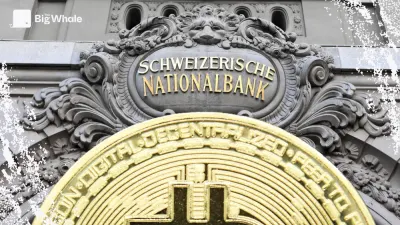TBW - Market makers' techniques for manipulating the markets

Everyone who has been involved in trading on a market - be it equities, digital assets, commodities or financial derivatives - is familiar with these entities that act as liquidity providers. Market makers inject the liquidity needed to optimise the functioning of the market through the buying and selling of assets.
They play a crucial role and facilitate trading. However, their sole objective remains profit maximisation. Their interventions influence market forces and direct asset prices according to their interests, often resulting in significant losses for ordinary participants.
This analysis examines the problematic aspects of their practices and operations.
Functioning of market makers
Market makers provide liquidity on asset trading platforms. In the world of digital assets, they operate on both centralised and decentralised platforms. On centralised platforms, all pending buy and sell orders are recorded in an order book.
To add liquidity, market makers place limit orders above and below the current price. They pay fees to the platform, which are generally lower than those charged to traders placing market orders.
Liquidity plays an essential role: it allows traders to trade assets without causing large price swings. A transaction occurs when a buyer and a seller agree on a price. The "bid price" represents the maximum amount a buyer is prepared to pay, while the "ask price" corresponds to the minimum amount a seller agrees to receive.
The difference between these two prices, known as the "spread", has a direct influence on transaction costs. The wider the spread, the higher the costs and the fewer the participants. In illiquid markets, "slippage" occurs - execution prices deviate from expected prices due to insufficient liquidity.
Market makers reduce these spreads to make trading more fluid. Their strategies include grid trading (Image 1), delta-neutral market making, cross-platform arbitrage, unhedged market making and two-leg trading. In periods of low activity, they can steer prices in the desired direction.

On decentralised exchanges (DEX), like Uniswap, market makers provide liquidity via Automated Market Makers (AMMs), which use liquidity pools rather than traditional order books. Users trade directly with these pools, while liquidity providers receive trading fees.
Price spreads are generally higher on DEXs due to lower liquidity and higher volatility. Although most DEXs use MAs, some platforms have opted for order book systems: Demex with an on-chain solution and dYdX with an off-chain system.
Market makers' business model
Market makers use three main business models to manage their risks and acquire assets: fixed fees, call option loans, and self-management.
Fixed fee model: Market makers charge a fixed fee in exchange for providing liquidity and stabilising bid-ask spreads. These fees vary depending on the size of the market and the token pairs traded. Clients (the projects that issue tokens) bring a combination of native tokens and stablecoins for trading. To ensure security, market makers access accounts via API keys rather than direct transfers, leaving custody to the issuers. Although issuers control market performance indicators, they bear the capital risk. To compensate for fixed fee limitations, some agreements include profit sharing mechanisms.
Lend with call option model: In this model, token projects lend assets to market makers and grant them call options. This approach encourages the provision of liquidity while transferring risk to the market makers. While this system limits issuers' potential losses, it also reduces their possible gains. The contracts, which run from six months to three years, require rigorous monitoring to prevent manipulation. Some include liquidity obligations to maintain stable prices.
Self-managed model: Issuers employ market maker technology directly for a recurring fee. This solution offers complete autonomy over strategies and custody of assets. However, it requires advanced expertise in market making, and issuers bear all the trading risks.
Market manipulation techniques
Market manipulation consists of a set of deliberate strategies that benefit their executors, in particular the market makers.
Here are the main manipulation strategies used:
- Front-running: Market makers, having access to order book data, can see the large buy or sell orders to come. Having the necessary resources, they anticipate these movements by first pushing the price in the desired direction. For example, when a large buy order arrives, they push up the token price before executing larger sells, maximising their profits after the initial order is executed.
- Stop-loss hunting: Holders strategically push prices below key support levels, triggering a cascade of long position liquidations. They then take positions at lower prices. They may also create false breakouts to force the liquidation of short positions.
- Spread manipulation: In volatile markets, market makers may reduce liquidity to optimise their inventory management while widening the bid-ask spread, thereby increasing trading costs. Conversely, they sometimes tighten spreads in stable markets to boost volume and collect more fees.
- Spoofing: Market makers place large fictitious orders with no intention of executing them. These orders create a false impression of demand or supply, influencing other traders. Once the desired price movement has been achieved, they cancel these orders.
- Wash trading: Takers artificially inflate volumes by trading between their own accounts, creating the illusion of strong interest to attract new traders.
- Pump and dump systems: Takers artificially inflate the price of an asset through coordinated purchases or the dissemination of false information. Once the price is high enough, they liquidate their positions, causing prices to collapse.
Price manipulation on decentralised trading platforms (DEXs)
Price manipulation on decentralised trading platforms (DEXs) occurs when rogue liquidity providers (LPs) exploit automated market makers (AMMs) to manipulate token prices. On DEXs, where transactions take place between users and liquidity pools, attackers can become market makers and employ a variety of tactics.
One is to provide one-sided liquidity by adding only a single token to the pool, increasing its supply and reducing its relative value. LPs can also perform a "rug pull" by draining liquidity from pools, mainly by withdrawing established assets such as BTC or stablecoins.
Oral manipulation is another widespread strategy. Attackers target platforms with low liquidity to create artificial prices and fool DEX oracles, forcing pools to rebalance at manipulated rates. The attack on Mango Markets in 2022 illustrates this type of manipulation, causing a $100 million loss on the MNGO token.
Trading bots and algorithms also participate in these manipulations by spotting and pre-empting pending trades, causing artificial price inflation or disadvantageous executions. In addition, wash trading is carried out via several portfolios controlled by the same LP, generating fictitious volume to mislead other traders.
Meteora's role in the LIBRA token manipulation
The LIBRA token affair has highlighted the excesses of decentralised finance, where platforms that are supposed to guarantee market transparency are sometimes transformed into manipulation tools for insiders. Meteora AMM, far from being a mere neutral intermediary, played an active role in managing LIBRA's liquidity pools, allowing the project's organisers to walk away with millions of dollars before the market collapsed, leaving retail investors trapped with worthless tokens.
In contrast to traditional platforms where liquidity is often managed by independent players, Meteora was not content to provide passive infrastructure. Its role in LIBRA lay in its direct control over the management of liquidity pools. Thanks to its automated market maker (AMM) model, Meteora did not simply store funds deposited by users, but actively redistributed liquidity through its own algorithms. This capability gave it the power to influence LIBRA token price movements, an advantage that was exploited by insiders to organise a massive pump-and-dump.
Ever since LIBRA was launched, Meteora has facilitated an asymmetric liquidity structure, allowing the project's organisers to sell their tokens en masse at artificially high prices. Normally, a liquidity pool needs to be balanced between two assets to ensure a degree of price stability. But thanks to the mechanisms put in place by Meteora, insiders were able to inject large quantities of LIBRA while simultaneously withdrawing other assets from the pool, notably stablecoins such as USDC and Solana (SOL). This process artificially kept the price of LIBRA high, attracting an influx of buyers convinced that the rise was legitimate.
At the same time, Meteora's role in this fraudulent scheme was strengthened with the intervention of Kelsier Ventures, a fund run by Hayden Davis, which directly contributed to the connection between Meteora and the LIBRA project. This collaboration enabled the organisers of the scandal to benefit from privileged access to the liquidity infrastructure, giving them greater control over market developments. With the support of Kelsier Ventures, a small circle of insiders were able to benefit from exclusive access to liquidity mechanisms, allowing them to exit the market with considerable profits before the public realised the token's imminent collapse.
Meteora's influence in this affair did not stop there. Several investors and analysts have raised accusations of favouritism, claiming that the platform deliberately structured its liquidity system so that only insiders and certain influencers could profit from artificial price rises. By manipulating liquidity pools and facilitating the accumulation of LIBRA by a few players, Meteora helped to reinforce the illusion of massive demand for the token, encouraging more retail investors to enter the market just before the collapse.
Faced with the revelations, Ben Chow, co-founder of Meteora, tried to play down his platform's involvement by denying any involvement in fraudulent practices. He did, however, admit to having put Hayden Davis in touch with several dubious projects, including LIBRA, which fuelled suspicions as to the extent of his knowledge of events prior to the crash. Pressure from the DeFi community and aggrieved investors eventually led him to resign, although Meteora's legal responsibility for the affair remains unclear.
While Meteora did not directly orchestrate the rug pull, his role in actively managing LIBRA's liquidity and his links to the project's organisers make him a key player in the manipulation.


Other cases cases
👉 FTT manipulation
Another form of wash trading emerged after the FTX collapse. In December 2022, the US Securities and Exchange Commission (SEC) charged key figures at Alameda Research and FTX for participating in manipulative practices to artificially inflate the price of FTX's FTT token. According to the SEC, this was achieved by purchasing large quantities of FTTs on the open market to create an illusion of demand and price stability.
👉 Wintermute Charges
Market maker Wintermute faces serious charges in a class action lawsuit for its alleged participation in a fraudulent scheme with former Celsius CEO Alex Mashinsky. The plaintiffs allege that Wintermute engaged in "wash trading" and other manipulations to artificially inflate the value and trading volume of the Celsius CEL token between March 2021 and the platform's collapse in June 2022. These manoeuvres allegedly misled investors by creating the illusion that the CEL token was more valuable and liquid than it was, thereby contributing to Celsius's downfall.
Despite Wintermute's denial of any improper trading practices, the case highlights the potentially damaging impact of its activities on market conditions. Although the company has not been directly implicated in Ponzi schemes or conventional financial fraud, it remains under close scrutiny for questionable business practices. The numerous hacking incidents and identity theft scams it has fallen victim to have also tarnished its reputation in the crypto ecosystem. These controversies raise serious questions about the integrity of Wintermute's operations and its role in manipulating the digital asset market. The case is currently taking its legal course.
👉 DWF Labs' alleged involvement in pump and dump schemes
Market maker DWF Labs has been accused of participating in pump and dump schemes and market manipulation on Binance. According to a former Binance insider, the exchange's investigation team uncovered $300 million in wash trading linked to the company. These activities, which allegedly violated Binance's terms of use, included manipulating the price of the YGG token. DWF Labs has categorically rejected these allegations, describing them as FUD (fear, uncertainty and doubt) orchestrated by its competitors. The accusations come amid intense scrutiny of crypto market makers, while other players such as Wintermute and GSR are also under scrutiny for their perceived unethical business practices.
👉 Jump Trading's involvement in the Terra Luna and UST collapse
Jump Trading has been the subject of a class action lawsuit for allegedly manipulating the price of Terra's UST stablecoin in 2021. According to the plaintiffs, Jump, in collusion with Terraform Labs (TFL) and its CEO Do Kwon, secretly purchased more than 62 million UST tokens to artificially maintain its $1 peg, misleading investors about its true value and risks. In return, Jump allegedly obtained LUNA tokens at a steep discount, enabling it to pocket more than $1.28 billion before Terra collapsed in May 2022.
Conclusion
Market making is essential to creating optimal trading conditions in any market. Sufficient liquidity allows traders to execute their orders instantly. Market makers who operate ethically and transparently have a beneficial effect on the assets traded: they increase trading volumes, reduce volatility and transaction costs, encouraging natural price appreciation and attracting more investors.
However, the lure of huge profits often drives market makers, MAs and trading firms to abandon legitimate practices in favour of market manipulation. LIBRA's recent pump and dump scandal is a perfect illustration of these excesses, revealing the fraudulent behaviour of automated market makers and insiders using sniping bots.
Large market making firms such as Wintermute, DWF Labs and Jump Trading have been embroiled in numerous dubious activities in recent years. This raises crucial questions about their role in the development of a healthy and sustainable crypto ecosystem. While the pursuit of profit is legitimate for any business, a clear line must be drawn between maximising gains and maintaining fair trading conditions for all. Protecting retail investors, who do not have access to inside information, is essential to the sustainable development of the digital asset ecosystem.



